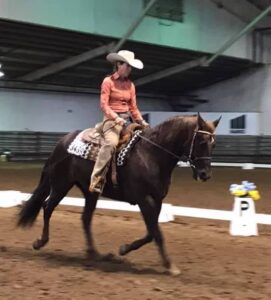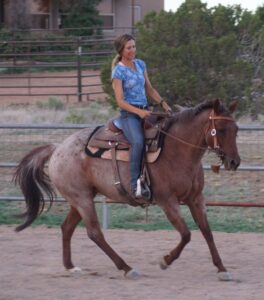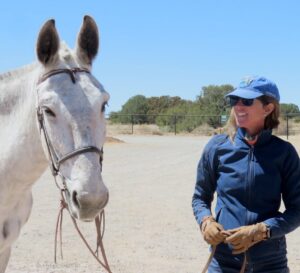Editor’s Note: Best Horse Practices Summit presenter Katrin Silva grew up riding dressage in Germany before moving to the United States at age 19 to learn to ride Western. She’s been riding both disciplines for the last 20 years and is a regular guest columnist for Cayuse Communications. The author of Dressage for All of Us: How to Help Any Horse Become a Happier, More Responsive Riding Partner and the forthcoming Ride with Feel: A Guide for the Rest of Us lives in New Mexico where she works with dressage and Western clients.
Katrin Silva writes:

Katrin at a Western Dressage event
In my early twenties, I spent several years as an assistant trainer at Quarter Horse show barns.
I soon realized that training a successful Western show horse has little to do with bringing out the best in the horse. It has to do with presenting a picture the judge wants to see:
- a saddle with lots of silver
- the horse’s mane neatly banded
- the rider wearing the right kind of chaps.
Also, the horse has to look and move a certain way. If he does not, he will never win.
A Western all-around prospect needs to be born with a long, low-set neck and move with minimal knee or hock action. Otherwise, there is little point in training him at all.
It’s a world in which a horse’s show record determines his value, where horses are divided into those who are talented, which makes them worth training, and those considered unworthy. It’s a tough place for horses. It’s a tough place for trainers.
I left this world to strike out on my own. I fell back in love with dressage, both with the training principles and the competitive sport, which, in New Mexico during the 1990s, seemed more inclusive and welcoming than the Quarter Horse shows.
 Back then, everyone, amateur or professional, rode the kind of horses I rode: Quarter Horses, Morgans, Arabians, off the track Thoroughbreds. I enjoyed competing in those days.
Back then, everyone, amateur or professional, rode the kind of horses I rode: Quarter Horses, Morgans, Arabians, off the track Thoroughbreds. I enjoyed competing in those days.
But how the sport of dressage has changed drastically in the US, even here in New Mexico, since then! Most horses are now Warmbloods, bred to be exactly what the dressage judge wants to see enter at A. These horses are born with a huge overstep at the walk and trot. They are born with an arched neck. They are born with powerful, elastic movement.
I know: correct training can develop any horse’s topline and make any horse’s steps more rhythmic, more elastic. But all the correct training in the world can’t make a 15-hand Quarter Horse move or look like a 17-hand Hanoverian.
I know: a talented horse still needs correct training. Talent needs to be developed. Even a talented horse can be ruined through incorrect training and training shortcuts.
The unfortunate priorities that have plagued Western Pleasure now seep through dressage: If you are a trainer whose career depends on high scores, wouldn’t you rather train a horse who has the potential to earn those high scores than a horse who, even with correct work, lacks that potential?
Today’s dressage shows and those Western shows of the 90’s (and probably now, too) are about the picture the judge wants to see: neat button braids, jeweled brow bands, white gloves, horses moving with big, elastic steps and spring-loaded hind feet. Horses who don’t look or move like that are becoming a rare sight, even at the lower levels.
 I keep hearing that this is a good thing. I keep hearing that “The quality of the horses at our dressage shows has improved so much!” But is this really a good thing for the horse world? Is this really a good thing for all horses?
I keep hearing that this is a good thing. I keep hearing that “The quality of the horses at our dressage shows has improved so much!” But is this really a good thing for the horse world? Is this really a good thing for all horses?
How can we convince judges to reprioritize what matters?
Why can’t judges be charged with nurturing, guiding, and rewarding what really matters for the horse and its development and for best in horse-rider accomplishments?
Dressage is so much more more than a sport. It’s a solid basis of good training for any horse. It’s a tradition of horsemanship that builds happy, long-term, horse-rider partnerships. It benefits all horses – not just those with the huge overstep and uphill canter. Not just those who are capable of scoring well in competition.
I am a dressage trainer who loves to work with nontraditional dressage horses. I believe, more than ever, that dressage is good for all horses. My horses become better horses through dressage – more balanced, sounder, stronger, more responsive, happier.
And yet, why compete? Why show these lovely horses, only to be laughed out of the ring?
Competition is less of a focus for me nowadays. But I feel for other trainers who are not as lucky with their clients’ and their clients’ priorities. Just like their counterparts in the Western world, dressage trainers see horses divided into those worth training and those who are not, conforming to pictures judges want to see. This means many horses who could benefit from correct dressage training will never get it. And it makes me sad.
Great article, very great article.
Enter Working Equitation where all breeds have an equal chance of being in the winners circle. A BLM mustang or a AQHA cow horse may outscore the Warmbloods and Lucitanos. It’s a super welcoming sport with fun competitors of all ages cheering you on.
Spot on, Katrin. Over 40+ years of training for the public, I’ve watched Western Pleasure become something that is neither Western, nor a pleasure, and dressage has moved away from its roots in form-to-function. Judges and trainers seem to have lost the vision of what an individual horse CAN do to move correctly, versus what they believe they SHOULD do to place. Compound this with “back-scratching” in the show pens and “monkey-see, monkey-do” from one World Show or Congress to the next, and the problem proliferates. But it every discipline is afflicted with fads; it’s a human trait. It’s also characteristic of humans to mistake “different” for “better”, and “activity” for “progress”. Let’s just strive for movement and attitude that’s optimal for the job within the limits of conformation and mechanics.
I agree. I personally never liked to show. I practiced my dressage training out in the woods on trails. Those who primarily trail ride would really benefit taking some dressage lessons. But I can’t seem to sell this to them. Sad. I will keep trying.
Let us not forget that most types of showing are becoming increasingly geared toward only those who have the financial wherewithal to purchase the best and blingiest. This comment is not meant to discredit the talented, dedicated, and hard working riders who put in the hours to achieve their dreams.
It is my hope that articles like yours, and the many who agree, will grow stronger voices and bring about a change for the better of all horses.